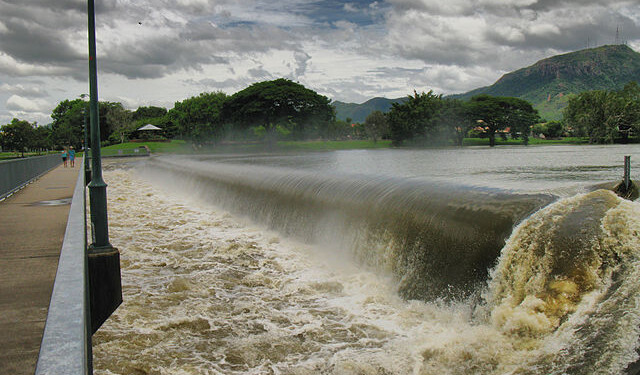The 23rd annual Sydney Biennale exhibition is open and propels an important conversation — climate change and its relation to water. Colombian director José Roca mentions this year’s theme is “rīvus,” meaning streams.
With the focus on streams and different types of waterways, the exhibit offers a deep examination of all things to do with water, referring to the present increased climate struggles including ocean pollution and heavy flooding.
While art fans from around the globe travel to see the showcase, the message comes at a significant time for Australians as floods wreak havoc on communities country-wide.
Eastern Australia has experienced floods for weeks
Over a 16 day period of heavy and overbearing rainfall, at least 22 known deaths have pledged the eastern part of the country. Now Prime Minister of Australia Scott Morrison is citing the cause of these floods to be climate change.
As the latest assessment by the Intergovernmental Panel on Climate Change(IPCC) warns, rising temperatures will drastically increase the number of 100-year floods to occur several times a year.
Australia has seen these extreme cases of destruction, including heatwaves, droughts, floods, storms and fires. Periods of extreme drought and flooding have varied in Australia for the past decade — posing a weather forecast of contradictions.
In 2019, Australia experienced one of its worst drought seasons in history, with some places having an annual rainfall of less than one-fifth of the long-term average.
The next year, Lake Carnegie, located in the western part of Australia, received an overwhelming 270 mm of rain in a single day when it usually averages a total of 235 mm of rainfall a year.
Communities across Australia are now experiencing rainfall record highs again that are leading the way to dangerous flooding.
These flood monitoring cameras demonstrate the extent of the rainfall and just how quickly waters rose, causing major damage during the recent #seqfloods
pic.twitter.com/56CnQfuHp0
— Queensland Reconstruction Authority (@QReconstruction) March 8, 2022
Just this past week, Sydney has reported its wettest ever 16-day stretch, receiving 24 inches between February 24 through March 9. On March 3, residents were even told to evacuate their homes due to unexpected flash flooding.
Other communities such as Brisbane and the small town of Dunoon have also seen heavy, life-threatening rain.
Between February 24 and February 28, Brisbane was hit with 26 inches within a four-day span. By the end of the week, Brisbane reached a historic high of 31 inches.
Eclipsing Brisbane, Dunoon received 30 inches of rain in just 24 hours on February 28.
Coincidentally, the exhibits represents Australia’s latest climate casualty
Joining together 89 participants from around the globe, the exhibit showcases 330 pieces of artwork focused on bringing awareness to climate change and its effects on water.
Referred to as Imbás – a well at the bottom of the sea – artist Clare Milledge concentrates her art piece on ocean pollution. Using a silk camping tent as the “bottom of the sea,” she includes copper cauldrons, coils of shipping and climbing rope to illustrate the various items that reside at the bottom of the sea.
British-Finnish artist, composer and performer Hanna Tuulikki was also present at the event with her new music video “Seals’kin,” which entails the mythical Norse selkies — who were known to transform from seals to humans, shedding their skin each transformation. In the folklore, humans were said to be abducted to the kingdom of orseals and trapped underwater after shedding their skin; Tuulikki came to believe this was an allegory for loss and longing in coastal communities.
Several Australian local artists also had a message to tell at the biennale.
Trawlwoolway artist Julie Gough put together a collection of videos from her kayaking trips and offered up her trusty kayak to be displayed and suspended from the roof of the biennale exhibit. Her latest trip paddling down to the end of the Mersey river and finding what she believes was a native rock — representative of the last rock of native people — is the message behind her videos.
Avid waterway activist and Barkandji artist Badger Bates incorporated his black and white cutouts of Australia’s tributaries and lakes of the Barka (Darling River) — appearing as high walls filled with canoes and other sculptures. Bates’ work represents how fish and other wildlife species are often killed by local industries that produce chemical waste.
Behind the exhibit, Colombian film director Roca states that artists and their work represent an important and timely message — to protect the environment and give its inhabitants a voice on their climate struggles.
“Rivers, wetlands and other salt and freshwater ecosystems feature in the biennale … as dynamic living systems with varying degrees of political agency,” said Roca. “Indigenous knowledges have long understood non-human entities as living ancestral beings with a right to life that must be protected. But only recently have animals, plants, mountains and bodies of water been granted legal personhood. If we can recognize them as individual beings, what might they say?”
Whether a coincidence of weather or a storyteller with an eye for the future, the biennale’s message certainly comes at a prevalent time as Australia experiences devastating flooding and harsh weather conditions brought on by the increase of global warming and rising emissions. Nevertheless, the collaboration of the biennale and the everlasting rain outside seems to collectively stand as a lesson for needed reform — to save local communities from the hazard repercussions of climate change.
Editor’s Note: The opinions expressed here by Impakter.com columnists are their own, not those of Impakter.com. Featured Photo: Ross river flooding in Queensland, Australia on January 1, 2011. Source: Rob and Stephanie Levy, Wikimedia.









